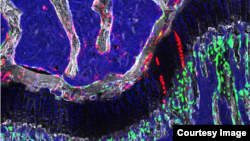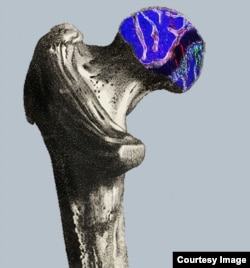Osteoarthritis is a common condition seen in older people in which the tissue between joints becomes worn down, causing severe pain. In what could be an important development for people who suffer from it, U.S. researchers have isolated stem cells in adult mice that regenerate both worn tissue, or cartilage, and bone.
For the past decade, researchers have been trying to locate and isolate stem cells in the spongy tissue or marrow of bones of experimental animals.
The so-called osteochondroreticular, or OCR, cells are capable of renewing and generating important bone and cartilage cells.
Researchers at Columbia University Medical Center in New York identified these master cells in the marrow. When grown in the lab and transplanted back into a fracture site in mice, they helped repair the broken bones.
Siddhartha Mukherjee, the study's senior author, said similar stem cells exist in the human skeletal system.
“The real provocative experiment or the provocative idea is being able to do this in humans — being able to extract out these stem cells from humans and being able to put them back in to repair complex fracture defects or osteoarthritis defects,” said Mukherjee.
He noted that children have more bone stem cells than adults, which may explain why the bones of young people repair more easily than fractures in adults.
Mukherjee said the next step is to try to identify the OCR cells in humans and attempt to use them to repair complex bone and cartilage injuries.
Once cartilage is injured or destroyed in older people, as in osteoarthritis, Mukherjee said it does not repair itself.
The research was funded by the U.S. National Institutes of Health and the American Cancer Society, among others, and is described in a paper published online in the journal Cell.







